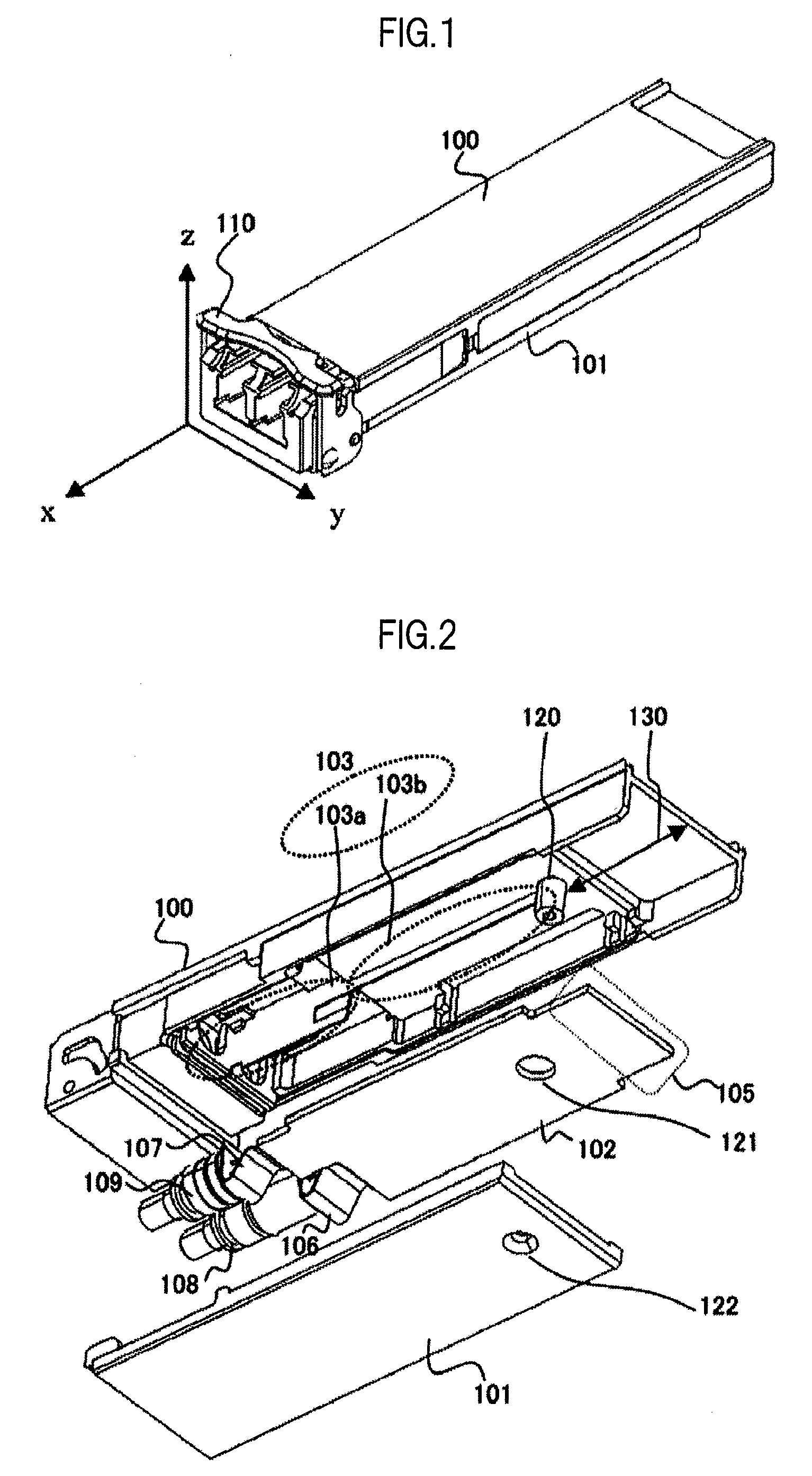Optical transceiver module
a technology of optical transceiver and optical module, which is applied in the direction of optical elements, semiconductor lasers, instruments, etc., can solve the problems of insufficient reduction effect, insufficient inability to meet the specific radiation of unnecessary electromagnetic waves, so as to reduce unnecessary electromagnetic waves, increase cost, and reduce the effect of unnecessary electromagnetic waves
- Summary
- Abstract
- Description
- Claims
- Application Information
AI Technical Summary
Benefits of technology
Problems solved by technology
Method used
Image
Examples
first embodiment
[0038]A first embodiment of the present invention is described with reference to FIGS. 1 to 6. FIG. 1 is a structural view illustrating an appearance of an optical transceiver module according to the first embodiment of the present invention. FIGS. 2 and 3 are exploded perspective views illustrating inner structures of the optical transceiver module according to the first embodiment of the present invention viewed from upper and lower directions. FIG. 4 is a graph showing a change in cavity resonant frequency in an inside of a casing for describing an effect of the first embodiment of the present invention. FIGS. 5 and 6 are graphs showing improvements of a case shield effect for describing an effect of the embodiment of the present invention.
[0039]First, a configuration of the optical transceiver module is described with reference to FIGS. 1 to 3. The optical transceiver module according to the first embodiment is compliant with XFP MSA (SFF Committee INF-8077i, “10 Gigabit Small F...
second embodiment
[0058]A second embodiment of the present invention is described with reference to FIGS. 7 to 9. FIG. 7 is a view illustrating an inner structure of a lower casing according to the second embodiment of the present invention. FIGS. 8 and 9 are graphs showing improvements of a case shield effect for describing an effect of the second embodiment of the present invention. The optical transceiver module according to the second embodiment is also compliant with XFP MSA, but is different from that of the first embodiment, as illustrated in FIG. 7, in that the no partition wall is provided on the lower casing 111 and that the lower casing 111 is formed of a sheet metal product. Similarly to the first embodiment, the partition wall 103 is provided on the upper casing 100 (not shown). As a material for the lower casing 111, a stainless plate, a steel plate, or the like is used.
[0059]FIG. 8 is a graph comparing the case shield effect between a case in which the partition wall is provided in the...
third embodiment
[0062]A third embodiment of the present invention is described with reference to FIGS. 10 to 15. Also in this embodiment, the x-direction is defined as “front”, and the z-direction is defined as “upper”. FIG. 10 is a structural view illustrating an appearance of an optical transceiver module according to the third embodiment of the present invention. FIGS. 11 and 12 are views illustrating inner structures of the upper and lower casing of the optical transceiver module according to the third embodiment of the present invention. FIG. 13 is a view illustrating a positional relationship between the partition walls and the printed circuit board of the optical transceiver module according to the third embodiment of the present invention. FIG. 14 is a graph showing a change in cavity resonant frequency in an inside of a casing for describing an effect of the third embodiment of the present invention. FIG. 15 is a graph showing an improvement of a case shield effect for describing the effec...
PUM
 Login to View More
Login to View More Abstract
Description
Claims
Application Information
 Login to View More
Login to View More - R&D
- Intellectual Property
- Life Sciences
- Materials
- Tech Scout
- Unparalleled Data Quality
- Higher Quality Content
- 60% Fewer Hallucinations
Browse by: Latest US Patents, China's latest patents, Technical Efficacy Thesaurus, Application Domain, Technology Topic, Popular Technical Reports.
© 2025 PatSnap. All rights reserved.Legal|Privacy policy|Modern Slavery Act Transparency Statement|Sitemap|About US| Contact US: help@patsnap.com



